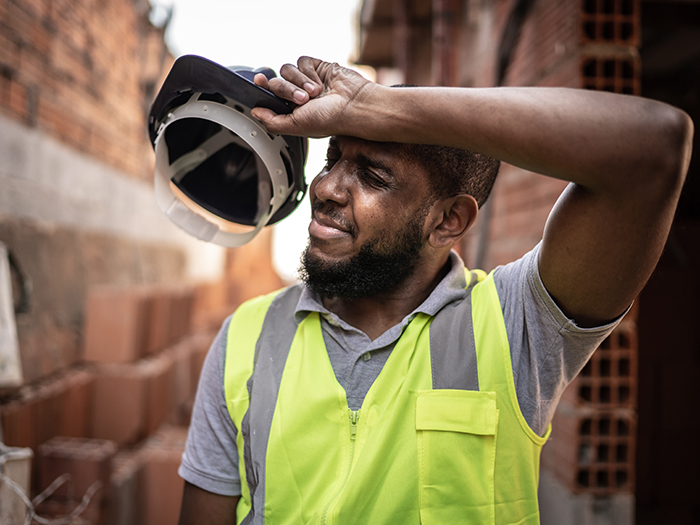Extreme Heat and Skilled Labor Shortages Are Just Some of the Risks Construction Faces

Of all the emerging and growing risks affecting the construction industry, the impact of climate change may be the most complicated.
Dynamic risk profiles make underwriting and insuring the future-focused construction industry a challenge even without the added complexity of changing weather patterns. But a changing climate introduces new risks where they did not exist before — like a construction site with a growing risk of flooding or a crew working outside in sustained hotter-than-usual temperatures.
A session at the recent IRMI Construction Risk Conference in Orlando raised this timely concern.
Moderator Jay Hurin, risk solution construction services manager at Markel, was joined by panelists Eric Davis, managing director, construction and infrastructure at Aon; Valarie Jonas, director of construction claims at Markel; and Guenter Kryszon, global executive underwriting officer, property at Markel, for a session entitled “The Impact of Climate Change on Construction.”
Climate-related hazards affect the construction industry — and by extension its insurers and reinsurers — and the impact will only increase as weather patterns become more volatile.
The construction and insurance industries must adapt and develop controls to mitigate these climate-related challenges or risk decreased efficiency, missed deadlines and worker injury.
Climate Change-Related Exposures Affecting the Construction Industry
A changing climate means the risk environment is constantly evolving.
Construction businesses must stay on top of these changes to adequately protect themselves and their customers.
Likely, this will involve changing their insurance portfolio to keep up with the risk, but as the panel pointed out, more can be done.
“You have to have great solid project risk management fundamentals, which involves both contractual risk protection and insurance protection,” said Davis.
“You have to manage contracts from a construction perspective and, in the end, from the lens of climate change.”
He pointed to some ways construction firms can protect themselves contractually, including considering if changing weather patterns will begin to affect a site differently or how the force majeure clause is defined and triggered in a contract.
Firms may encounter risks on site that they didn’t expect as climate change continues to affect the world.
It isn’t just the impacts of climate change affecting construction risk, either; Jonas explained how the pressures of population inflation, migration and a changing labor supply compound climate change risks on construction sites.
“One of the big stressors you see on the claims side is the lack of skilled labor in construction,” Jonas said.
“You have the skilled workforce that is retiring so they’re not on site to train new folks. We have a concurrent pressure of a boom in the industry and a need for labor, and you have [workers] coming over the border with different language sets.”
As new employees are perhaps being rushed on site without proper training — or with a language barrier that precludes any training that is offered — the of risk injury rises.
And with hotter-than-ever conditions spurred by the changing climate, this risk is exacerbated.
Jonas told the audience about a worker who suffered from a heat-related illness, but his coworkers mistook it for a drug episode, as they had not been trained to recognize heat-related symptoms, nor how to alleviate them.
Construction and Insurance Industry Partner Together to Reduce Losses
Partnering together, the insurance and construction industries can put measures in place to reduce losses and remedy some of these challenges.
Jonas recommended that construction sites have extreme heat plans they can quickly put in place when rising temperatures warrant it.
Some states have regulations allowing investigators to go to construction sites when temperatures exceed 90 degrees Fahrenheit to monitor working conditions, so having a plan is advisable.
Jonas said, “It’s really important that construction projects have a plan, that they implement the plan, and they can show they have that plan.”
She mentioned things like hydration stations and having shade available for workers.
Jonas explained that, due to high heat, the “amount of work time in each day is going to be condensing.”
In the future, when daytime temperatures exceed safe conditions, laborers will need to stop working. That unavoidable loss of productivity could be costly if there isn’t a plan in place to offset it.
In addition to ensuring workers take breaks, construction firms can move to protect people during high heat and humidity events and other severe weather conditions by implementing such measures as:
- Offering hydration stations and shaded areas
- Instituting rest and other breaks for workers
- Cycling crews out of adverse conditions frequently
- Training crews and management on the symptoms, treatment and prevention of heat-related illness and injury.
Contractually, firms can account for slower work progress due to these heat-related measures. Kryszon elaborated on how construction firms might look at heat-related delays and schedules.

Guenter Kryszon, global executive underwriting officer, property, Markel
“If you’re going to be building a project in a northern climate, you’re generally going to bake some time into the schedule for weather days, snow days, rain events, things like that. And I think the shift now, especially when talking about heat-related exposures in some Southern states, is that contractors need to bake in some time like the northern climates would for severe weather.”
While it certainly makes sense to add in time for severe weather to protect workers from exposure to hazardous storms, these delays also cause other risks to the construction project.
In addition to the costs associated with a delay, Jonas pointed out that the longer a building project goes on, the more likely it is that construction defect claims will arise later as a result of the additional exposure to weather; water intrusion claims are the most likely to impact a delayed property.
The need for further action from both the construction and insurance industries is clear.
Climate change continues to have an outsize impact on the construction industry — and the disruptions from severe storms and changing weather patterns may only worsen over time.
The right blend of risk mitigation, preparation and adaptability will be required of both industries — and when the stakes include human lives, we must get this right. &










